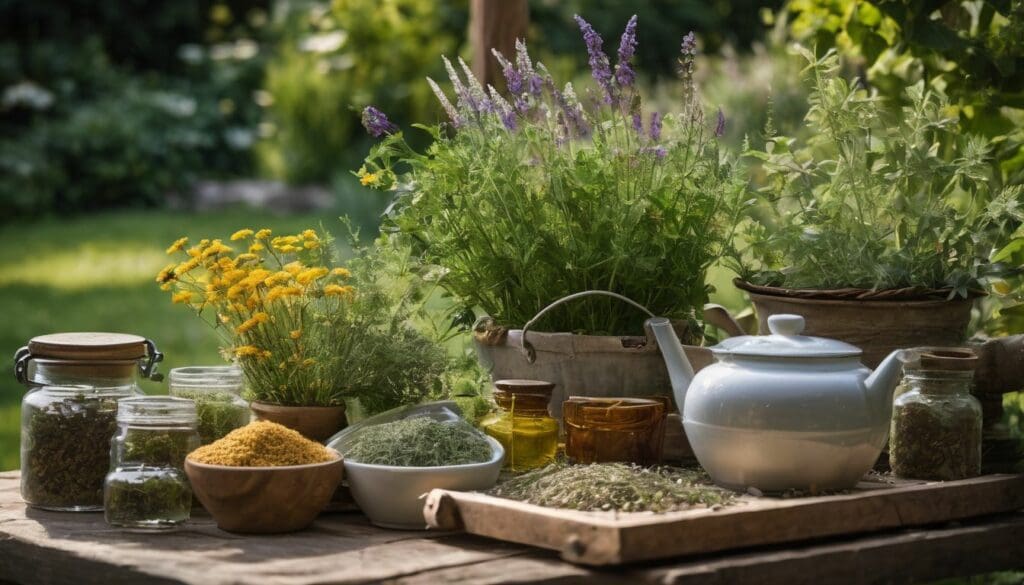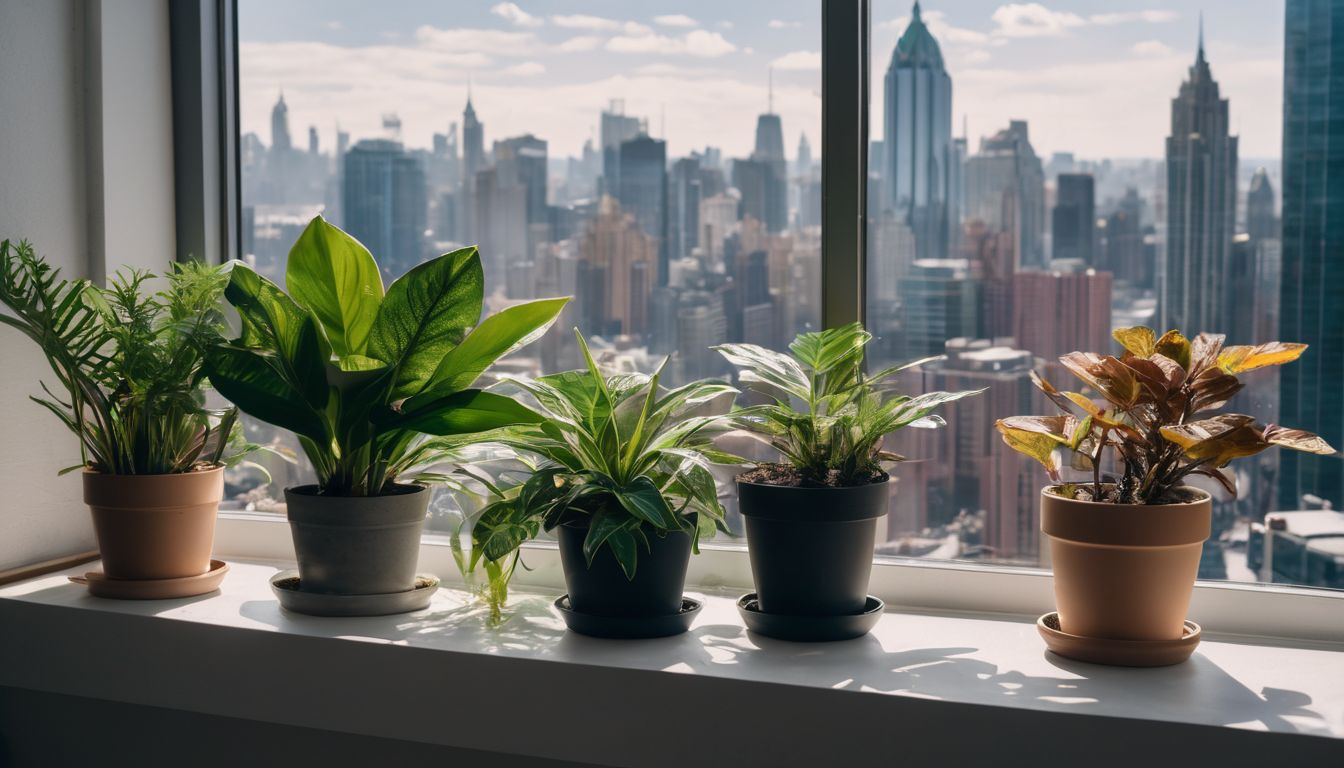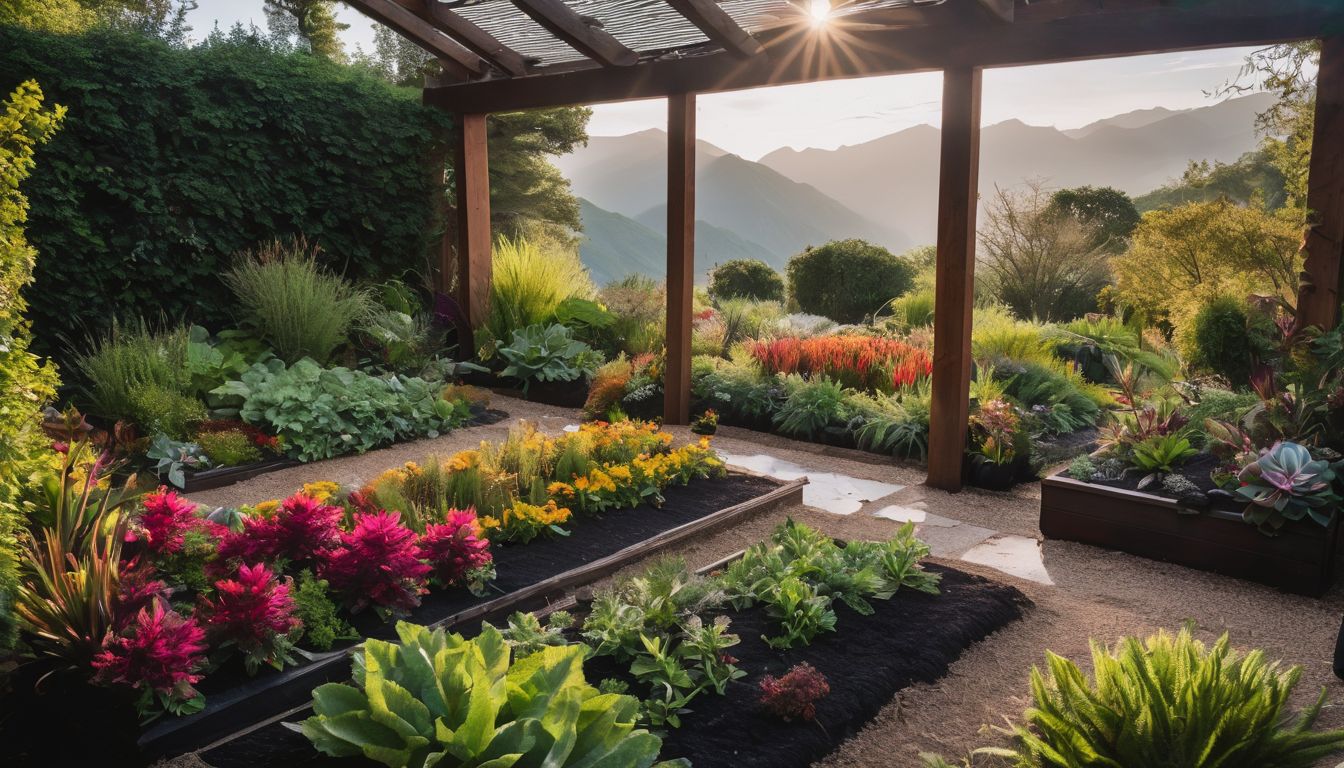Are you looking for natural ways to boost your health and wellness? Medicinal herb gardens have been treasured for centuries, offering a wealth of healing benefits right at your fingertips.
This blog will guide you through the simple steps to create your own garden filled with healing herbs. Let’s dig in and plant the seeds of well-being!
Key Takeaways
- Starting a medicinal herb garden can enhance your well – being and support natural health care by allowing you to cultivate plants with healing properties.
- Choose the location for your garden carefully, ensuring there’s enough sunlight, easy access to water, and good drainage; consider vertical spaces for efficiency in small areas.
- Select herbs that meet your specific health needs and that can thrive in your local climate, planning the layout of the garden to accommodate their growth requirements.
- Use quality organic soil and implement proper watering practices to promote robust plant growth while being mindful of environmental sustainability.
- Harvesting at the right time maximises each herb’s medicinal value, which can then be preserved through drying or infusing in oils for various homemade remedies.
Why Start a Medicinal Herb Garden?
Growing your own medicinal herbs provides numerous benefits, including increased self-sufficiency and cost savings, as well as a deeper connection to nature. By cultivating your own herbal remedies, you can take charge of your health in a natural and sustainable way.
Benefits of growing your own herbs
Cultivating medicinal plants in your garden offers the purest form of natural remedies. Every snip of homegrown basil or rosemary carries not just flavour but also the satisfaction of organic gardening.
You gain control over what goes into your soil and onto your plants, ensuring that the herbal remedies you create are free from harmful chemicals. This approach aligns with a holistic healing philosophy, preferring plant-based medicine straight from nature.
Harvesting herbs from your own backyard ensures freshness and potency in every leaf. Imagine having a living pharmacy at your fingertips, where treatments for common ailments are just steps away.
By choosing native species suited to your growing zone, you nurture biodiversity and strengthen local ecosystems – a win-win for both conservation efforts and environmental wellness advocates.
With each plant tended, you actively participate in sustainable practices that benefit both human health and our planet’s ecological balance.
Increased self-sufficiency and cost savings
Cultivating a medicinal herb garden promotes self-sufficiency and offers substantial cost savings. By growing your own herbs, you reduce reliance on store-bought alternatives and their associated costs.
It’s an sustainable way to access natural medicine that aligns with environmental values, offering a budget-friendly approach to holistic wellness.
A homegrown herb garden not only provides essential medicinal plants but also empowers individuals to take charge of their health naturally. This resourceful practice significantly reduces the need for purchasing expensive herbal remedies while promoting sustainability and conservation efforts.
Connection to nature
Connecting to nature through herb gardening can be a fulfilling experience. Cultivating your own medicinal herbs allows you to engage with the natural world, promoting biodiversity and sustainability.
By tending to your herbs, you become more attuned to seasonal changes, weather patterns, and the interconnectedness of all living things.
Growing a medicinal herb garden also helps you appreciate the healing properties of plants and fosters a deeper understanding of traditional herbalism. Your homegrown herbs not only provide health benefits but also reduce reliance on commercial pharmaceuticals and contribute towards a healthier planet.
Embracing this connection to nature through herb gardening empowers individuals to take an active role in their well-being while supporting environmental conservation efforts.
Choosing the Right Location for Your Herb Garden
When choosing the right location for your herb garden, consider factors such as sunlight, water, and drainage. Utilising vertical space can also help maximise your garden’s potential.
Considerations for sunlight, water, and drainage
Choosing the right location for your herb garden is crucial for the successful growth of medicinal herbs. Here’s what you need to consider:
- Ensure that your chosen location receives an adequate amount of sunlight, as different herbs have varying light requirements. A minimum of six hours of direct sunlight is ideal for most medicinal herbs.
- Check the drainage of the area to prevent waterlogging, which can be detrimental to herb growth. The soil should allow excess water to drain away effectively.
- Water availability is essential, so choose a location that allows easy access for watering your herbs. Consider the proximity to a water source or the feasibility of installing a drip irrigation system.
Utilising vertical space
To make the most of limited space, consider using vertical planters or hanging baskets. These are great options for small gardens or urban environments. This approach helps maximise sunlight exposure and allows you to grow a larger variety of herbs in a smaller area.
Additionally, vertical gardening can be an attractive and functional solution for those with physical limitations, making it easier to tend to your medicinal herb garden.
Consider adding trellises or stakes for climbing herbs such as thyme, rosemary, and mint. Utilising walls and fences by installing shelves or utilising pockets designed for planting can create more room while contributing to a visually appealing garden space.
Planning Your Medicinal Herb Garden
Determine your needs and choose a suitable location for your medicinal herb garden. Select the right herbs, plan your garden layout, and get started with planting to create a thriving herbal sanctuary.
Determine your needs
Assess your health requirements, such as common ailments or conditions you wish to address with medicinal herbs. Consider the space available for planting and the time you can dedicate to gardening.
Identify your preferred method of using the herbs – whether it’s for teas, tinctures, or topical applications. Research the suitable growing conditions for the specific herbs that align with your needs.
Select plants based on their healing properties and growth suitability in your area. Assess if you require easy-care varieties or have experience cultivating more delicate species.
Choose a suitable location
Evaluate your outdoor space for a suitable location, considering the amount of sunlight, access to water, and proper drainage. Look for areas with at least 6 hours of direct sunlight per day and ensure that nearby sources of water are easily reachable.
Assess the drainage in the area to prevent waterlogging which can harm your herbs.
Consider utilising vertical space if you have limited ground space, such as walls or trellises, to maximise your herb garden potential. This ensures that you can grow a variety of herbs even in smaller spaces.
Select the right herbs
Selecting the right herbs for your medicinal herb garden is crucial. Consider your needs and preferences when choosing which herbs to grow. Evaluate the different properties and uses of each herb, such as pain relief, immune system support, or digestion aid.
Some popular options include lavender for relaxation, peppermint for digestion, and echinacea for immune support.
When selecting herbs, ensure they are suitable for the climate in your area to promote healthy growth. Take into account any specific health conditions or concerns you may have that can be addressed with herbal remedies.
Plan your garden layout
After selecting the right herbs for your medicinal garden, it’s time to plan the layout. Consider the space needed for each herb and their growth habits. Group herbs with similar water and sunlight needs together to make caring for them easier.
Utilise raised beds or containers if you have limited space, ensuring good drainage is in place. Also, leave room for pathways and access points.
When planning your garden layout, keep in mind spacing requirements of each herb variety as well as any companion planting arrangements that can promote growth and protect against pests naturally.
Get started with planting
To start planting your medicinal herb garden, follow these steps:
- Prepare the soil by clearing any debris and weeds from the chosen area.
- Dig individual holes for each herb, ensuring they are spaced according to their specific growth requirements.
- Gently remove the herbs from their pots, carefully loosen the roots, and place them in the prepared holes.
- Press the soil firmly around the base of each plant to secure it in place.
- Water the newly planted herbs thoroughly and continue to provide regular watering as needed.
- Consider using natural mulch around the base of each plant to help retain moisture and prevent weed growth.
- Monitor the growth of your herbs and adjust care practices as needed based on their individual needs.
Managing Soil and Water in Your Herb Garden
It’s important to maintain good soil quality for your medicinal herbs, so choose the right type and ensure proper watering and drainage techniques. This will help your plants thrive and provide you with a bountiful harvest of beneficial herbs.
Importance of good soil
Good soil is crucial for the successful growth of medicinal herbs. It provides essential nutrients and a suitable environment for the plants to thrive. The right soil composition ensures that the herbs receive adequate moisture, air, and support for healthy root development.
Choosing high-quality, organic soil with good drainage promotes sustainable gardening practices and reduces reliance on chemical fertilisers. By prioritising the importance of good soil in your medicinal herb garden, you contribute to overall environmental conservation efforts and support biodiversity in your local ecosystem.
Choosing appropriate soil for your medicinal herb garden aligns with environmentally conscious practices while promoting plant health and sustainability. Using rich, well-draining organic soil supports optimal growth conditions without compromising environmental integrity or natural resources.
Choosing the right soil
To ensure the successful growth of your medicinal herbs, it is crucial to choose the right soil. The first step is to assess the drainage and texture of the soil in your chosen location.
Look for well-draining soil with a light, crumbly texture that allows air and water to move freely. Additionally, consider conducting a soil test to determine its pH level and nutrient content.
Once you have assessed these factors, you can then amend or supplement the soil with organic matter such as compost or well-rotted manure to create an optimal growing environment for your medicinal herbs.
Proper watering and drainage techniques
After choosing the right soil for your medicinal herb garden, it’s essential to ensure proper watering and drainage techniques. Here’s how to do it:
- Watering: Use a watering can or hose with a gentle flow to water the herbs at the base, ensuring that the soil is moist but not waterlogged.
- Mulching: Apply organic mulch around the plants to retain moisture and prevent evaporation.
- Drainage: Ensure that the garden bed has good drainage by incorporating organic matter into the soil and using raised beds if necessary.
- Avoid overwatering: Monitor the moisture levels in the soil and adjust your watering schedule based on weather conditions.
Harvesting and Using Your Medicinal Herbs
Once your medicinal herbs are mature, it’s time to harvest and preserve them for use in teas, tinctures, or oils. Read more to learn about the best practices for harvesting and using herbal medicine in your daily life.
Tips for harvesting and preserving herbs
Harvesting herbs at the right time is crucial for preserving their medicinal properties. Follow these expert tips to ensure you get the most out of your medicinal herb garden:
- Harvest herbs early in the morning before the sun gets too hot, but after any dew has dried.
- Use sharp scissors or pruners to make clean cuts on stems, and avoid tearing or bruising the leaves.
- Choose to harvest when the plant is at its peak, usually just before it flowers.
- Dry your herbs in a warm, dark, well – ventilated area to preserve their potency.
- Store dried herbs in airtight containers away from light and heat to maintain their freshness.
Ways to use medicinal herbs
Using medicinal herbs can be an excellent way to support your health and well-being. Whether it’s brewing a soothing cup of chamomile tea for relaxation or creating homemade salves from calendula flowers for skin irritations, the possibilities are endless.
You can also infuse oils with aromatic lavender for aromatherapy or incorporate fresh herbs like mint and basil into your cooking for added flavour and potential health benefits.
Harnessing the power of medicinal herbs allows you to explore natural remedies while connecting with the earth. Experimenting with different herbal preparations, such as tinctures, teas, poultices, or even simply adding them to bath soaks, offers a holistic approach to wellness that has been embraced by cultures around the world for centuries.
Conclusion
In conclusion, starting a medicinal herb garden offers numerous benefits, including increased self-sufficiency and cost savings. Choosing the right location is crucial for successful herb cultivation; consider sunlight, water, and drainage.
Planning your garden layout based on your needs and selecting suitable herbs are essential steps to get started with planting. Managing soil quality and watering techniques will ensure healthy growth of your medicinal herbs.
Lastly, harvesting and preserving herbs is key to enjoying their benefits while also contributing to sustainable living practices.
FAQs
1. What do I need to know before selecting herbs for my medicinal garden?
When starting a medicinal herb garden, consider the types of plant-based medicine you’re interested in, as well as which herbal plants are suitable for your climate and soil.
2. How should I care for my herbal plants in the garden?
Your growing herbs will thrive with proper soil preparation, regular watering, and attention to their specific needs.
3. Can I integrate both traditional and alternative medicine herbs in one garden?
Absolutely! You can mix various botanicals used in traditional and alternative medicine to create a diverse healing space.
4. Are there special gardening tips for maintaining a healthy medicinal herb garden?
Yes, researching each herb’s requirements and implementing those gardening tips ensures your herbs grow robustly, providing the best yield for plant-based medicine.





